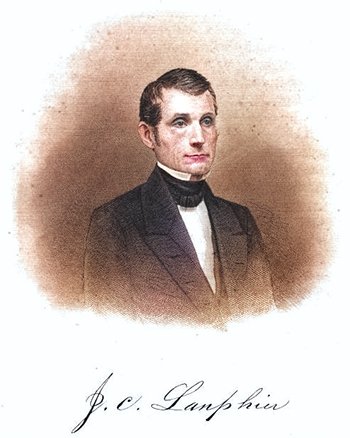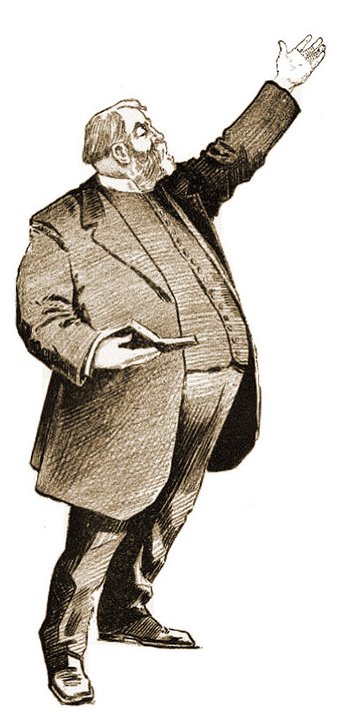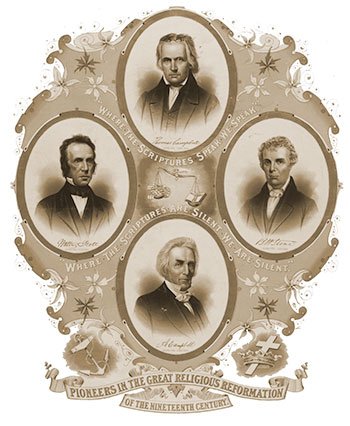1857 Layman’s Prayer Revival

Jeremiah Lanphier
The Layman’s Prayer Revival of 1857-1858, also known as the Businessman’s Revival and the Prayer Meeting Revival, was a profound religious awakening that swept across the United States, leaving an indelible mark on its social and spiritual fabric. Sparked by a simple prayer meeting, this revival ignited a fervent desire for prayer and spiritual renewal throughout the nation, leading to numerous conversions and enduring societal transformations.
Antecedents of the Revival
The years preceding the Layman’s Prayer Revival were characterized by a confluence of social, economic, and spiritual factors that created a fertile ground for religious awakening.
Economic Instability
The early 19th century witnessed a period of economic recovery and expansion, but this growth was accompanied by underlying anxieties. The banking industry experienced a surge in investments, leading to the formation of an economic bubble that threatened to destabilize the nation’s financial system. This economic uncertainty contributed to a sense of vulnerability and a search for stability.
Social Divisions
The issue of slavery continued to fester, creating deep divisions within American society and even among churches. This moral and political conflict further fuelled a sense of unease and a longing for unity and reconciliation.
Spiritual Decline
Adding to the nation’s anxieties was the “Great Disappointment” of 1844, when William Miller’s prediction of Christ’s return proved false. This event led to widespread disillusionment with Christianity and a decline in religious fervour. The rapid westward expansion, the discovery of gold in California, and the rise of industrialization further contributed to this spiritual decline by fostering materialism and a focus on worldly pursuits.
Amidst this spiritual downturn, a group of concerned Christians in Boston, led by the Old South Church, began to earnestly pray for revival. For eight years, they persistently sought God’s intervention, their prayers growing increasingly fervent in 1857. This collective yearning for spiritual renewal played a crucial role in setting the stage for the Layman’s Prayer Revival.
The Spark that Ignited a Nation
The revival’s genesis can be traced to the actions of Jeremiah Lanphier, a businessman who had experienced a life-altering conversion under the ministry of Charles Finney at the Broadway Tabernacle in 1842. This connection to the Second Great Awakening and its emphasis on personal experience and social action profoundly shaped Lanphier’s approach to evangelism.
In 1857, driven by a deep burden for the lost, Lanphier accepted a position as a city missionary with the North Dutch Church on Fulton Street in Manhattan. Recognizing the need for spiritual renewal in the bustling city, he organized a noon prayer meeting for businessmen, envisioning a space for prayer and reflection amidst the demands of daily life.
Lanphier actively promoted the prayer meeting, distributing flyers and posters that encouraged both men and women to attend. These posters often included the message: “Daily prayer meeting, from 12-1 o’clock, STOP 5, 10, or 20 minutes, or the whole hour, as your day admits.” The first gathering, held on September 23, 1857, on the third floor of the Consistory of the Old Dutch Reformed Church on Fulton Street, was attended by a mere six individuals. However, the number of participants steadily increased, and the prayer meeting soon became a daily event, drawing people from all walks of life.
The Distinctive Character of the Revival
The Layman’s Prayer Revival possessed several unique characteristics that contributed to its widespread appeal and lasting impact.
Firstly, the revival was deeply rooted in prayer. The meetings revolved around prayer requests, with attendees writing down their concerns and submitting them to the leader. The leader would then read these requests aloud, inviting others to pray. To ensure that everyone had an opportunity to participate, prayers were generally kept brief and focused.
Secondly, the revival was largely led by laypeople, rather than ordained clergy. This lay leadership fostered a sense of shared responsibility for spiritual renewal and empowered ordinary individuals to actively participate in the movement. The meetings were also intentionally non-denominational, welcoming people from various Christian traditions. This emphasis on unity and shared faith transcended denominational barriers, creating a sense of collective purpose and fostering a spirit of cooperation among diverse groups of believers.
Thirdly, the revival was characterized by a sense of urgency and immediacy. The prayer meetings were often held during lunch breaks, with participants carving time out of their busy schedules to seek God. This practice reflected a deep conviction that prayer was not merely a religious obligation but a vital necessity in a time of national crisis.
Furthermore, the prayer meetings followed a specific format and guidelines to maintain order and focus. These guidelines included time limits on prayers, a prohibition of controversial discussions, and an emphasis on shared participation. Each meeting typically began with a hymn and Scripture reading, followed by prayer requests and concluding with another hymn and a closing prayer. Personal testimonies were also a prominent feature of the revival, with participants sharing their experiences of conversion and spiritual growth.
The Revival Spreads Like Wildfire
News of the Fulton Street prayer meetings rapidly spread through various channels, including newspapers, the recently established telegraph, and word of mouth. Similar prayer meetings began to emerge in other cities across the United States, including Pittsburgh, Washington D.C., and Charleston, South Carolina. The revival extended beyond the borders of the United States, reaching Canada and other parts of the world.
The financial panic of October 1857, which resulted in widespread economic hardship and uncertainty, further fuelled the revival’s momentum. This crisis intensified the desire for spiritual solace and guidance, leading many to seek answers and comfort in faith. The press played a significant role in disseminating news of the revival, with newspapers like the New York Daily Tribune reporting on the growing religious fervour and its connection to the economic crisis.
The revival’s influence also extended to the realm of government and public life. In March 1858, prayer meetings began to be held in the halls of the New York state capitol, with growing numbers of legislators and public officials participating.
Fruits of the Revival: Conversions and Transformations
The Layman’s Prayer Revival had a profound impact on individuals and communities throughout the nation. Thousands experienced conversions, turning from lives of sin and indifference to embrace faith in Christ. Churches reported significant growth in membership, with some denominations witnessing a surge in conversions. The Methodist Episcopal Church, for instance, recorded over 8,000 conversions in a single week in February 1858.
Among the many individuals touched by the revival was Orville “Awful” Gardner, a notorious boxer known for his rough and violent lifestyle. Gardner’s conversion through the prayer meetings served as a powerful testament to the revival’s transformative power.
The revival’s impact extended beyond individual conversions, leading to notable social changes. Crime rates declined, and there was a renewed emphasis on social responsibility and compassion for the poor and marginalized11. Wealthy individuals extended generosity to those in need, recognizing a shared humanity and a common bond in Christ. The revival fostered a spirit of unity and cooperation, transcending social and economic divides.
Furthermore, the revival had a significant impact on family life. Family altars were strengthened as families gathered for prayer and spiritual reflection. Religion became a frequent topic of conversation in social settings, reflecting the revival’s pervasive influence on everyday life.
The effects of the revival were felt for decades, with its influence enduring for at least 40 years. Even during the tumultuous years of the Civil War, the revival’s impact continued to be felt. Revival meetings were held in military camps, and a significant number of soldiers, including over 150,000 in the Confederate Army alone, experienced conversions.
The revival’s reach extended to unexpected places, including ships arriving in New York harbor. There were reports of captains and sailors experiencing conversions as their ships came under the influence of the prevailing spirit of prayer and spiritual awakening.
Lasting Legacy and Lessons Learned
The Layman’s Prayer Revival left an enduring legacy on American society and the broader Christian world. It demonstrated the power of prayer to bring about personal and societal transformation, highlighting the importance of lay involvement in spiritual renewal and the potential for unity across denominational lines.
The revival’s emphasis on prayer as a vital response to national crisis continues to resonate today. In times of uncertainty and social upheaval, the Layman’s Prayer Revival serves as a reminder of the transformative power of collective prayer and the importance of seeking God’s guidance and intervention.
The revival’s timing, just a few years before the outbreak of the Civil War, suggests that it may have played a crucial role in preparing the nation spiritually for the challenges and trials that lay ahead. By fostering unity, promoting prayer, and emphasizing spiritual values, the revival may have helped to strengthen the moral fabric of American society during a period of intense division and conflict.
The Layman’s Prayer Revival offers several valuable lessons for contemporary society:
- The Power of Prayer: The revival underscored the transformative power of prayer, both for individuals and communities. It demonstrated that prayer can bring about spiritual awakening, moral renewal, and social change. This lesson continues to inspire contemporary Christians to engage in fervent and persistent prayer for personal growth, community transformation, and national revival.
- Lay Involvement: The revival highlighted the crucial role of laypeople in leading and sustaining spiritual movements. It emphasized the shared responsibility of all believers to actively participate in the work of the Kingdom. This principle encourages modern-day churches to empower laypeople to take ownership of their faith and contribute to the spiritual growth of their communities.
- Unity in Diversity: The revival transcended denominational barriers, bringing together Christians from various traditions to pray for a common purpose. It demonstrated the power of unity and cooperation in advancing the Gospel. This example inspires contemporary Christians to seek common ground and work together to address social issues and promote spiritual renewal.
- Response to Crisis: The revival emerged in a time of national crisis, demonstrating the importance of seeking God’s guidance and intervention in times of uncertainty and social upheaval. This lesson resonates with Christians today who face various challenges, including social divisions, economic instability, and moral decline.
- Social Impact: The revival led to positive social changes, including a decline in crime rates and an increase in compassion and generosity towards those in need. It demonstrated the potential for religious faith to inspire social action and address societal challenges. This legacy encourages contemporary Christians to actively engage in social justice initiatives and work towards creating a more just and compassionate society.
Timeline of the Layman’s Prayer Revival
| Date | Event | Location | Significance |
| March 6, 1857 | Supreme Court rules in the Dred Scott case | Washington D.C. | Exacerbates social divisions and fuels anxieties. |
| July 1, 1857 | Jeremiah Lanphier becomes a city missionary | New York City | Marks the beginning of Lanphier’s efforts to organize prayer meetings. |
| September 23, 1857 | First prayer meeting held at Fulton Street | New York City | Sparks the Layman’s Prayer Revival. |
| October 10, 1857 | New York stock market crashes | New York City | Triggers economic hardship and fuels the desire for spiritual solace. |
| November 1857 | Fulton Street prayer meetings expand | New York City | Reflects the growing popularity and impact of the revival. |
| Early 1858 | Reports of revivals appear in religious press | Various cities and towns | Indicates the spread of the revival to other cities and regions. |
| February 1858 | Methodist Episcopal Church reports surge in conversions | Nationwide | Demonstrates the revival’s impact on church membership. |
| March 1858 | Prayer meetings held in New York state capitol | Albany, New York | Shows the revival’s influence on government and public life. |
| May 1858 | Estimated 50,000 converts in New York City | New York City | Highlights the significant number of people impacted by the revival. |
| 1859 | Over one million converts reported nationwide | United States | Underscores the widespread reach and impact of the revival. |
| 1859-1862 | Revival continues to influence social and religious life | United States and beyond | Demonstrates the lasting legacy of the Layman’s Prayer Revival. |
Conclusion
The Layman’s Prayer Revival stands as a testament to the enduring power of faith and the transformative potential of prayer. It serves as an inspiration for contemporary Christians to seek God’s face, to unite in prayer, and to work towards spiritual and social renewal in their own communities.
In a world grappling with similar challenges to those faced in 1857 – economic uncertainty, social divisions, and spiritual apathy – the lessons of the Layman’s Prayer Revival are particularly relevant. The revival’s emphasis on prayer, lay involvement, unity, and social action provides a roadmap for contemporary Christians seeking to make a difference in their world. By embracing these principles, Christians today can contribute to a renewed spiritual awakening and work towards a more just and compassionate society.
Works cited
‘The Noon Prayer Meeting of the North Dutch Church, Fulton Street, New York’ Talbert W. Chambers
https://archive.org/details/ldpd_6221448_000/page/n7/mode/2up
4th Great Awakening 1857 – Revival Library
https://revival-library.org/timelines/1857-4th-great-awakening/
“Progress of the Revival, “New York Daily Tribune, April 24, 1858, under “page 6”
https://tile.loc.gov/storage-services/service/ndnp/dlc/batch_dlc_eggy_ver01/data/sn83030213/00206530583/1858042401/0166.pdf
“Religious Revivals. “New York Herald March 2 1858, under “page 4”
http://chroniclingamerica.loc.gov/lccn/sn83030313/1858-02-21/ed-1/seq-4.pdf
The Layman Prayer Revival of 1857-1858 – Justin Daniel
https://www.justincdaniel.com/2019/10/05/the-layman-prayer-revival-of-1857-1858/
America’s greatest spiritual awakening – How Revival Started in the Marketplace? – Wisdom Hunters https://www.wisdomhunters.com/69-2/
Revival Born in a Prayer Meeting – C.S. Lewis Institute
https://www.cslewisinstitute.org/resources/revival-born-in-a-prayer-meeting/
America’s Last Nationwide Revival: The Businessmen’s Revival of 1857-58
https://www.cuamerica.org/businessmens_revival
The 1857 Prayer Revival, Ep. 1: A Spark of Revival – YouTube
https://www.youtube.com/watch?v=kpy3HXPhYSM



